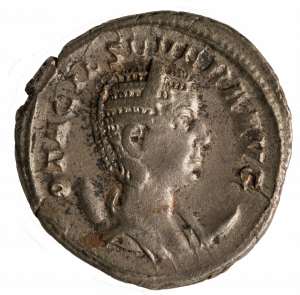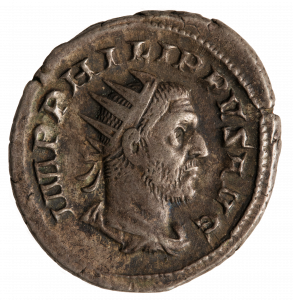Die Frau im Mond
Paul Götz
Die Büste der Kaisergattin Otacilia wird auf den Münzen unten von einer Mondsichel gerahmt. Diese ist das Attribut der Mond- und Jagdgöttin Diana. Was hat dies zu bedeuten?

Auch ihr Gatte, der Kaiser Philippus Arabs (244–249 n. Chr.), trägt das Attribut eines Gottes: Seine Strahlenkrone verweist auf den Sonnengott Sol Invictus, eine aus dem Orient nach Rom eingeführte Gottheit, die im dritten Jahrhundert n. Chr. intensiv verehrt wurde. Sol Invictus wurde als unbesiegtem (lateinisch: invictus) Gott besondere Macht zugesprochen. Somit werden Philippus und Otacilia als göttergleiches Herrscherpaar inszeniert: Beide ergänzen sich gegenseitig, so wie Sonne und Mond.
Die Mondsichel kann aber auch auf andere Weise verstanden werden: Diana wurde mit dem Beinamen „Lucifera“, die Lichtbringende, auch als Göttin der Geburt verehrt. Somit kann der Mond als Hoffnung auf kaiserlichen Nachwuchs interpretiert werden, welcher die Nachfolge des Kaisers sichern und so die turbulenten politischen und militärischen Verhältnisse stabilisieren sollte.
Außerdem war Diana für die Jagd zuständig. Im Kontext der veranstalteten Tierhetzen oder der Zurschaustellung von beeindruckenden und zum Teil exotischen Tieren kann der auf Philippus‘ Münze geprägte Mond auch als Ehrung und Dank an Diana für die enorme Anzahl der im Rahmen der Säkularspiele vorgeführten Tiere gelesen werden.
Die ludi saeculares feierten den Beginn einer neuen Epoche. Der auf der Münze abgebildete Mond erinnert an andere Münzprägungen, die neben einer Mondsichel auch einige Sterne zeigen. Somit wurde die Vorstellung, dass Planeten den Beginn eines neuen, glücklichen Zeitalters anzeigen, von Philippus passend zur Feier des tausendjährigen Bestehens Roms aufgegriffen.

这枚钱币上,皇后奥克塔奇里娅的半身像由一弯新月环绕着,这是月亮及狩猎女神狄安娜的圣物。在这里,它有何含义呢?
相应地,她的丈夫——皇帝“阿拉伯人菲利普”(公元244–249年在位)也佩戴着另一枚圣物:他头顶的“日晕皇冠”象征着太阳神索尔·因维克图斯——一位从东方引入罗马的神祗,在公元三世纪尤其受到崇拜。索尔·因维克图斯神被尊为“战无不胜之神”(源自意大利语“不败的”),象征着权力。
就这样,菲利普和奥克塔奇里娅被刻画成为一对与神齐名的皇帝伴侣:两者左右相伴,交相辉映,与日月同辉。
而这弯新月也可以用另一种方式来解读:
狄安娜又名“卢奇菲拉”,即“带来光明的女人”,有时也被奉为“生育女神”。因此月亮也可理解为对皇室子嗣的期盼。有了子嗣,皇位的承袭就有了保障,那么动荡不安的政治和军事困境就有希望得以平复。
此外狄安娜还掌管着狩猎。在逐兽表演争相举办,来自异国他乡的奇珍异兽大肆引人眼球的背景下,菲利普这枚钱币上铸造的月亮也可以理解为是对狄安娜的一种崇拜和感恩,感谢她为“百年节”的大型庆典带来数不胜数的奇珍异兽。
“百年节”是庆祝一个新时代的来临。在钱币上呈现的月亮也让人联想到其他的钱币,除了新月以外还有几枚繁星点缀着。这是因为按照罗马人的观念,星辰的出现是崭新的、美好时代开启的预兆。对菲利普皇帝而言,此时正值罗马建城1000周年,更是千年一遇的新起点。
A crescent moon frames the bust of the emperor’s wife Otacilia. This is the attribute of the moon and hunting goddess Diana. But what does it mean?
Her husband, emperor Philippus Arabs (AD 244–249) also wears the attribute of a god: his radiating crown symbolizes the sun god Sol Invictus, whose cult spread from the Orient to Rome and was intensely worshipped in the third century AD. Sol Invictus was believed to possess special power since he was an undefeated (Latin: invictus) deity. Thus, Philip and Otacilia are staged as a godlike pair of rulers: both complement each other, like moon and sun.
However, the crescent can also be understood in other ways: Diana was also called “Lucifera”, the light-bearer, and worshiped as the goddess of birth. Thus, the moon can be interpreted as the hope for an imperial offspring, to ensure the succession and thus to stabilize the turbulent political and military situation.
In addition, Diana was responsible for hunting. In connection with the organized animal hunting in the arena and the display of impressive and exotic animals, the moon minted on Philippus‘ coin can also be understood as gratitude towards Diana for the enormous number of animals presented during the secular games.
The ludi saeculares celebrated the beginning of a new epoch. The moon depicted on the coin is reminiscent of other coins that also show some stars together with a crescent moon. Thus, the idea that planets indicate the beginning of a new, happy age is taken up by Philippus Arabs while celebrating the 1,000 years’ anniversary of the foundation of Rome.
Bibliography:
- Frank Bernstein, Ludi publici. Untersuchungen zur Entstehung und Entwicklung der öffentlichen Spiele im republikanischen Rom (Stuttgart 1998).
- Edward Gibbon, Verfall und Untergang des römischen Imperiums. Bis zum Ende des Reiches im Westen, (München 2004).
- Christian Körner, Philippus Arabs. Ein Soldatenkaiser in der Tradition des antoninisch-severischen Prinzipats (Berlin 2002).
- Ludwig Preller, Römische Mythologie (Berlin 1858).
- Ute Schillinger-Häfele, Consules. Augusti. Caesares. Datierung von römischen Inschriften und Münzen (Stuttgart 1986).
- Thomas Wiedemann, Kaiser und Gladiatoren. Die Macht der Spiele im antiken Rom (Darmstadt 2001).
- Georg Wissowa, Paulys Realencyclopädie der klassischen Altertumswissenschaft (Stuttgart 1997).
